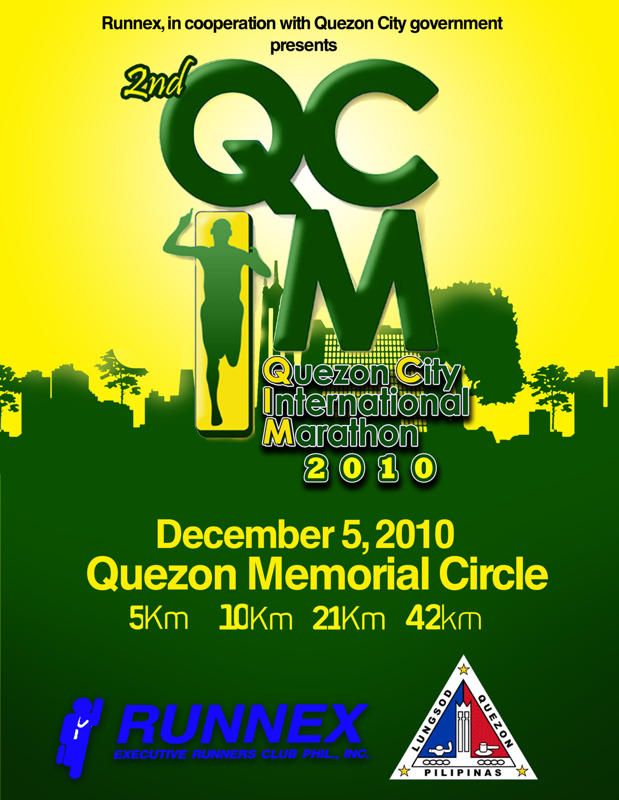Here are some thoughts on what made this latest marathon experience unique.

Wake up in the threes. The alarm clock is set for 3:15am. My internal alarm goes off a few minutes before. It must be nerves. I'm glad everything was laid out the night before: number pinned onto my shirt, timing chip secured in my left shoelace, semi-clean shorts, sports bra and socks (the pair the RnJ Laundry staff managed to find after they found out how much running socks cost) neatly folded in a pile at the foot of the bed near the gels and a small water bottle.
I stumble downstairs in the dark. Flip the switch to open the gas line on the stove. Boil water for the breakfast of champions: porridge and half a mango. It sticks to my stomach. Feels heavy, too heavy for a 3:20am meal. But not eating would feel worse ... in the race.
By 3:45, I'm out of the house. The gate key is tied to my right shoelace. The rest of my keys are hooked on the clothesline. I jog slowly to Quezon Memorial Circle, following the "open gate" route I'd scouted out earlier. (My place is in a semi-gated community. The gates are locked from 10pm to 5am. Had I taken my usual route that passes through locked gates I would miss the start of the race.)
Quezon Memorial Circle is aglow with Christmas lights. It's beautiful.
Hundreds of runners have already gathered at the designated muster point. Some stretch or jog in place. Others fiddle with race numbers, iPods and shoelaces. The queue for the port-o-potties grows by the minute.
A taho vendor walks through the crowd, hoping for some sales of this favourite Filipino snack. There aren't many takers.
It's still dark as the runners shuffle to the start line. It's on Commonwealth Avenue, right before the Philcoa overpass. When I first arrived in the Philippines, a good friend told me that the Philippine Coconut Authority (more commonly known as Philcoa) was the centre of the universe. In a sense, he's right. Informal vendors hawk wares of all shapes and sizes on the sidewalk. There are medical facilities, internet cafés, fast food joints, cell phone repair shops and banks. There are jeepneys, buses, taxis and tricycles available for hire. It's the Quezon City gateway to the rest of the world.
The race begins in the usual Filipino fashion. Local media personalities pump up the crowd. A municipal official delivers a speech. Someone prays, asking God to bless the runners, the race organizers, the fans, etc. A fitness club rep leads some warm-up stretches.
After much hoopla, the start gun is fired.
The beginning of the route is familiar, snaking along the roads I frequent on foot and by jeepney. It feels odd to run along Commonwealth Avenue, a heavily trafficked area nearly 24/7. One side of the divided highway is closed to traffic (well, mostly). Traffic on the other side is gridlocked. Drivers and passengers shoot dirty looks at us runners, silently cursing us for causing more traffic than usual.

Black shirt starts to tire at the turnaround point. I start the second half alone, then play cat and mouse with some runners in front of me. Runners en-route to the mid-way point offer encouraging words as our paths cross.
Back on Commonwealth Avenue, the crowd has grown. More spectators, more vendors, more jeepneys, more taxis, more tricycles. By kilometer 25, the crowd of runners swells. The marathon runners are joined runners in the shorter distances. Navigating through runner-traffic is not unlike weaving in and out of vehicle traffic.
I'm slowing down, but I don't have any kick left in me. I've had both my gels. I'm counting down the remaining distance in "UP laps." My head and legs know what they feel with five, four, three, two, one more lap to go. The actual lap around the academic oval feels great. As I exit the campus, I tell myself that I'm starting the penultimate lap. It's a comforting thought.
On Garcia, I hear a familiar voice. "Go Chris!" It's the laundry lady from RnJ Laundry. I'm delighted she's come out to watch the race.
With a kilometer left to go, onlookers are cheering wildly. Everyone seems to be yelling "only 200 meters left" - it's a looooong 200m. It's a relief to finally cross the finish line.
 |
| Finisher's medal |
Some finishing thoughts
The race wasn't particularly fast, at least by international standards. It could be because of the heat, the pollution, the humidity, the hills or any combination of these factors.The first male and female finishers run the race in 2:22:48 and 2:54:00, respectively. (The world records for the marathon are 2:03:59 - Haile Gebrselassie and 2:15:25 - Paula Radcliffe.)
Post-race people-watching is a snapshot of life in Quezon City. ~ Sandwiched between the post-race water kiosk and the Powerade kiosk is a vendor. He's selling cigarettes. In fifteen minutes, he makes a grand total of zero sales. ~ Street children mill around the finishing line. They collect empty plastic bottles. I give my unopened bottle of Powerade to a young girl. ~ Random runners approach me, inquiring if I am "the woman who runs at UP." They ask to have their picture taken with me. I happily oblige, and wonder what they will do with a photo of them with a sweat-drenched foreigner.
My race by the numbers
- 3:22:13 (gun time); 3:22:01 (chip time)
- 31st overall (out of 526)
- 9th female (out of 48) or 3rd, excluding the Kenyans (aka gazelles)
* * *
QCIM links
Race photos
Race results
Kenyans run show in Quezon City International Marathon (Philippine Star)





















.jpg)